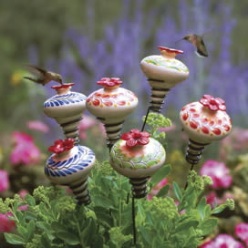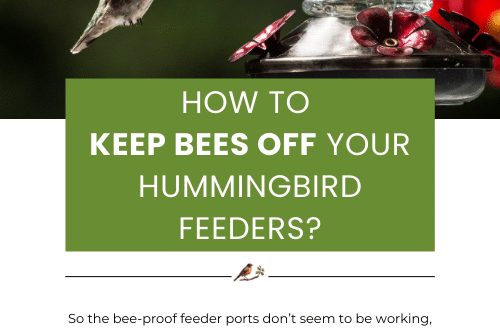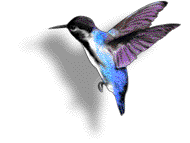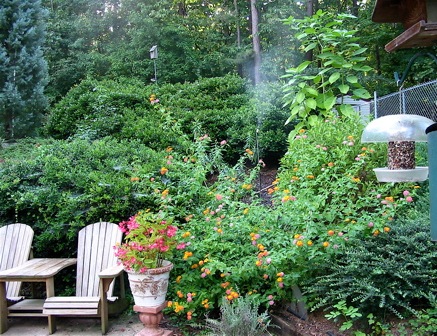-
Pollinate the Garden with Hummingbird Feeders
Hey, it’s National Pollinator Week!
One of those little things often taken for granted, pollinators play a huge role in the environment and our food sources. Albert Einstein said “if the bees go, we go four years later”. This is a scary thought, as bumble bees are now being considered one of the “at-risk” pollinators of today.
Hummingbirds are pollinators, and extremely beneficial in the garden. Sadly, more and more folks are saying they’re seeing less of the tiny sprites this year. The long harsh winter may have had an adverse affect on their migration, as there were no food sources upon arrival in the gulf states. Nothing was blooming yet from where they could draw nectar.
Photo by Cathy Keller Some other surprising pollinators include: hover flies, bats, native bees, moths, and certain beetles and wasps. Laying off the pesticides helps these species thrive, as well as using native plants in the landscape. Butterflies are also major pollinators, but unfortunately are also on the “at-risk” list. Over-ripe fruit is attractive to them, and also draws fruit flies which they’ll consume. Place a chunk of melon, orange, apple or strawberry on a plate in the garden for the flying gems.
Entice beneficial pollinators to your garden by keeping hummingbird feeders fresh! Sugar ferments and spoils after just a few days in the heat. Hummingbirds won’t touch it and may not even bother to check the feeder again. And ants, just one ant in the nectar ruins the whole batch! Use an ant moat to protect nectar from these pesky critters. A dab of petroleum jelly around the top of the hanger will also thwart ants, but tends to melt after a few days of extreme heat.
The solution should be changed every 2-3 days in hot weather. Consider making your own nectar so feeding the sprites isn’t as costly. Simply plain table sugar and water… no red dye needed! Nothing else should ever be added to the solution. One cup of sugar to four cups of water, the ratio is 1:4 sugar to water. Quick, easy and economical, store unused nectar in the fridge for up to two weeks.
Plant annuals and perennials that bloom throughout the season. Tube-shaped flowers are nectar producers, as well as native vines and salvia. Using these and other native plants in the garden provides a natural and steady food source for pollinators.
Leave some bugs. A great source of protein, hummingbirds and butterflies go after tiny insects (gnats, fruit flies and others) as a large part of their diet. With the spring nesting season and lots of babies out there now, insects are an important food source. If you’re using pesticides in the yard, stop! They’re no good for anyone 🙁
Fresh water is integral to all friendly fliers. If you’re lucky enough to have a pond, creek, or stream on your property, chances are great pollinators will visit. If not, consider adding a a shallow bath. A birdbath needn’t be fancy… just shallow and fresh. The maximum depth is just 2-3 inches, even a plastic plant saucer works well. If stagnant water is of concern, consider one of many bird bath accessories to keep the water moving. Water wigglers, bath drippers, solar fountains or leaf misters are just a few options that keep water fresher for longer periods, and prevent mosquitoes from laying eggs. Hummingbirds, butterflies and songbirds are attracted to these fun additions, and will stick around to use them daily.
So there you have it… celebrate National Pollinator Week by enticing these friendly fliers to your place!
-
Time to Dust Off those hummingbird feeders
The great hummingbird migration has begun!
Now is the time to get your hummingbird feeders out from storage and give them a good cleaning for the upcoming season. Plain hot water works, even if you send them through the dishwater, be sure to rinse them thoroughly to remove any residue. Along the Gulf of Mexico, Ruby Throats have started to claim territories, with other species following close behind.
Hummingbird season is an exciting one for many backyard birders, as these little sprites tend to provide some mesmerizing entertainment. Many folks could just sit and watch hummingbirds’ shenanigans for hours on end. Aside from the sugar water in hummingbird feeders, moving water is a very big attraction for them. Bathing, drinking and playing in birdbath fountains or bubblers comes naturally for hummers – they’re drawn to it like a magnet.
If you’re looking to attract more hummers, but already have enough hummingbird feeders, consider adding moving water to your landscape. Leaf misters for instance, are wildly popular among hummingbirds and butterflies as well. In the scolding heat of summer, the gentle mist is a most welcomed addition for many local wildlife species. Leaf misters may be installed in a variety of fashions. Ours stands upright in the garden twisted around a simple plant stake.
Treat your hummingbirds to a fun water feature this season and you’ll be rewarded by increased numbers and some fascinating activity and behaviors from the little guys!
Oh yeah… maybe this is the season to try making your own nectar too. It’s really quite simple and only takes a few minutes. Here’s the recipe: one part plain table sugar (cane) to four parts water. That’s it! Never use anything other than pure cane sugar (white table sugar) as it’s harmful to hummingbirds. There’s really no need to boil the water, we boil one cup simply to dissolve the sugar quicker and more effectively. If you do boil the water, be sure it has cooled before filling your hummingbird feeders. Store extra nectar in the fridge for up to two weeks. Now wasn’t that easy?





